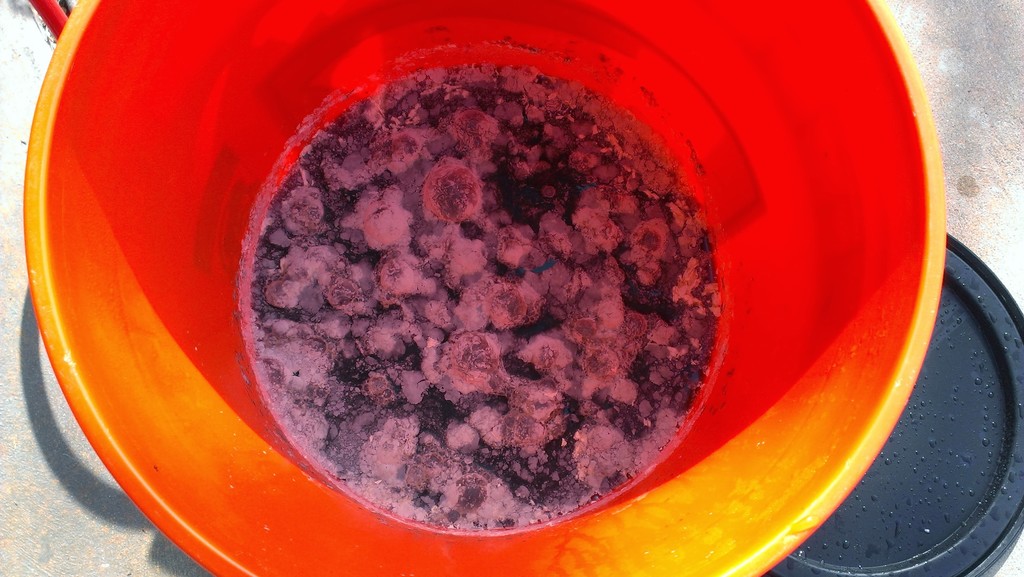There aren’t too many examples of hoppy and sour; they tend not to go well together. Besides the flavor clash the bacteria responsible for souring beer (mostly lactobacillus and pediocaucus) don’t do so well in highly hopped wort. Combine this with the general anxiety and fear of introducing bacteria into non-sour/non-brett production breweries and these beers just aren’t that common.
A local favorite, Black Star Coop, hosted a “Summer of Sour” celebrating sour beers and some of the techniques used to make them. My first sour beer adventure started after drinking an amazing tasting Berliner Weiss, called Waterloo, from Black Star. I emailed the head brewer at the time, Jeff Young, about how to make Waterloo. With his information as well as listening to him talk in the Sunday Session show about kettle souring or sour worting I took the plunge. Jeff is now starting up his own brewery, Blue Owl Brewing, which will focus exclusively on this technique for making sour beers.
Black Star coop released Dr. Vainglory, which is, as they call it, a Sour American Pale Ale (SAPA). It was a truly unique and tasty beverage, carefully balancing sour with lots of tropical notes and a firm, but not overpowering bitterness on the finish. Amazing.
After securing some Meridian hops, which were used in this strain, I decided, I’d give it a try. For souring, I’m using a blend of Gigayeast’s Fast Souring Lacto, and Wyeast Lacto. After 5 days at 76F, the starter was tremendously sour, a pH of about 3.4. I’ll be pitching this combination and keeping it at about 115F for about 4 days; which should create an extremely potent sour base. From there I’ll boil, hop, chill and then pitch a large starter of Brett B. Trois to finish off the rest of the gravity.
Recipe Details
| Batch Size | Boil Time | IBU | SRM | Est. OG | Est. FG | ABV |
|---|---|---|---|---|---|---|
| 6 gal | 60 min | 33.9 IBUs | 4.8 SRM | 1.050 | 1.013 | 4.9 % |
| Actuals | 1.046 | 1.01 | 4.7 % | |||
Style Details
| Name | Cat. | OG Range | FG Range | IBU | SRM | Carb | ABV |
|---|---|---|---|---|---|---|---|
| American Pale Ale | 10 A | 1.045 - 1.06 | 1.01 - 1.015 | 30 - 45 | 5 - 14 | 2.3 - 2.8 | 4.5 - 6.2 % |
Fermentables
| Name | Amount | % |
|---|---|---|
| Organic Brewers Malt 2-Row (Briess) | 10 lbs | 86.96 |
| Munich 10L Organic (Briess) | 1 lbs | 8.7 |
| Oats, Golden Naked (Simpsons) | 8 oz | 4.35 |
Hops
| Name | Amount | Time | Use | Form | Alpha % |
|---|---|---|---|---|---|
| Warrior | 0.18 oz | 60 min | Boil | Pellet | 15.7 |
| Ahtanum | 1 oz | 15 min | Boil | Pellet | 5.2 |
| Meridian | 1 oz | 5 min | Boil | Pellet | 6.5 |
| Meridian | 1 oz | 15 min | Aroma | Pellet | 6.5 |
| Palisade | 1 oz | 15 min | Aroma | Pellet | 7.8 |
Miscs
| Name | Amount | Time | Use | Type |
|---|---|---|---|---|
| Calcium Chloride | 3.20 g | 60 min | Mash | Water Agent |
| Gypsum (Calcium Sulfate) | 3.20 g | 60 min | Mash | Water Agent |
| Epsom Salt (MgSO4) | 0.40 g | 60 min | Mash | Water Agent |
Mash
| Step | Temperature | Time |
|---|---|---|
| Saccharification | 152°F | 60 min |
| Mash Out | 168°F | 10 min |
Notes
| DO NOT BOIL - Mash normally - Drain to Kettle - Raise temp to 176 for 15 minutes - Chill to 120F - pitch a pure culture of lacto and let ferment for approx. 2 days, no more than 3, retain 120F. - transfer the sour wort to the boil kettle - do my boil as per usual - chill to 70F - pitch my yeast culture. - After ferm complete, pitch peach puree |
Download
| Download this recipe's BeerXML file |


